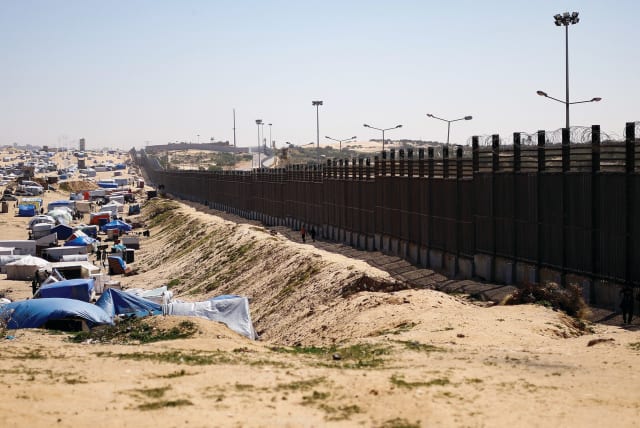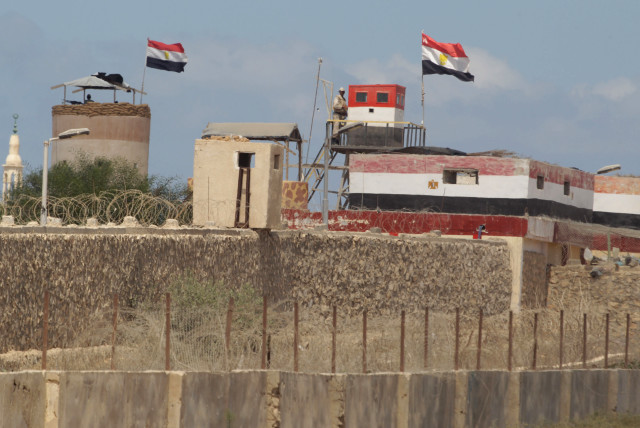Egypt preparing for Gazan influx and the rising price of leaving the Strip - opinion

All official cross-border travel has ceased, with the exception of foreign nationals and the severely injured, with cross-border movement still largely managed by Hala, which charges large sums.
On March 1, Sky News published the results of an in-depth investigation, revealing that an Egyptian company is charging Gazans $5,000 per person to escape to Egypt and that there is no shortage of customers. This method of fleeing Gaza through a specialist company is known as “coordination.” It is a long-established system by which Palestinians can pay for permission to leave the Gaza Strip and undertake the journey.
Before the war, there were a number of companies charging a few hundred dollars for the service. The fee was paid in advance, and within a few days, Palestinians escaping the Strip were taken across the border into Egypt.
Since the start of the war, all official cross-border travel has ceased, with just a handful of carefully vetted exceptions, such as foreign nationals and people with severe injuries, but “coordination” for the majority of those receiving permission to leave Gaza is still being operated by Hala.
Before the war, Hala charged $350 per adult for their service, now the price has risen to $5,000. Sky News states that it has verified this price by corroborating accounts from dozens of sources, including a Hala employee, as well as price lists posted online.
Hala's profits
Sky News used February 27 as an example. On that day, 246 Palestinians were registered to travel with Hala. That means the company could have made up to $1,083,900 in just one day. The news channel reported that the volume of daily passengers has been consistent for weeks.
A Hala employee told Sky News that the best way to register and pay for travel with the company was to send a relative to their head office in Cairo, based at the headquarters of its parent company, the Organi Group, in Cairo’s Nasr City district.
“The whole building is guarded with massive security,” said one source who had visited the office. Multiple sources affirmed that there were often hundreds or even thousands of people queuing outside. Videos showing the queues have been verified by Sky News.
“People are quite desperate,” one source said. “They are fundraising, they’re asking for money from their family members, doing whatever they can to raise very high sums of money, in order to pay for their own freedom.”
If indeed hundreds of Palestinians are making the crossing into Egypt every day, as the Sky News report maintains, where on earth are they to be accommodated?
The answer may lie in a report that appeared in the world’s media in February and has since dropped out of public view. On February 16, several global news sites reported that Egypt was constructing a walled camp in the Sinai Peninsula to receive displaced Palestinian civilians from the Gaza Strip.
The story was carried in The Wall Street Journal (WSJ) and supported by the Sinai Foundation for Human Rights, an Egyptian NGO, that released a report detailing and illustrating the construction of the compound, which it said was to receive Palestinian refugees “in the case of a mass exodus.”
The WSJ said an 8-sq. mile (21-sq. km.) “walled enclosure” that could accommodate more than 100,000 people was under construction on the Egyptian side of the border, part of “contingency plans” if ceasefire talks failed.
The Sinai Foundation confirmed that two contractors said that construction firms had been tasked with building the gated area, “surrounded by 7-m. high walls.” Indeed, the international news agency AFP reviewed satellite pictures taken on February 15 of the area in northern Sinai, showing machinery building a wall along the Egypt-Gaza border.
Humanitarian assistance and shelter for fleeing Palestinians
One source is reported as saying: “The area will be readied with tents” – while humanitarian assistance would be delivered inside.
The story, replete though it was with testimony and satellite videos, was flatly denied by North Sinai governor Mohamed Shousha. The construction work, he asserted, was to assess the value of houses destroyed during the running battles of recent years between Egyptian forces and Muslim Brotherhood insurgents operating against the regime in the region. The aim, he said, was to determine appropriate compensation for the owners.
In the early days of the war, Egypt’s President Abdel Fattah al-Sisi warned Israel against any “forced displacement” of Palestinians from Gaza into the Sinai desert. If that happened, he said, it could jeopardize the peace treaty Egypt signed with Israel in 1979. He said at a press conference back in October that Palestinians fleeing from Gaza could be moved to Israel’s Negev desert “till the militants are dealt with.”
In response, Israel’s Defense Minister Yoav Gallant has said that Israel had “no intention of evacuating Palestinian civilians to Egypt… We respect and value our peace agreement with Egypt, which is a cornerstone of stability in the region.”
Sky News asked Egypt’s foreign minister Sameh Shoukry whether the government condoned Hala charging $5,000 per adult for Palestinians to leave the Gaza Strip.
“Absolutely not,” said Shoukry. “We will take whatever measures we need to restrict it and eliminate it totally. There should be no advantage taken out of this situation for monetary gain.”
But Amr Magdi, an Egypt expert at Human Rights Watch, reportedly described Shoukry’s response as ringing hollow.
"It doesn’t make any sense,” he said.
“No one can pass through the border without the knowledge of the Egyptian authorities.” In other words, Hala, with its headquarters in Cairo, may be operating in Gaza with explicit or implicit official approval.
Egypt has categorically rejected any suggestion that Palestinians should be allowed to flee en masse into Sinai. But the problem Egypt may face, and is reportedly preparing for, is not any forced evacuation of Gazans by Israel, but the voluntary flight of desperate people able to find, beg, borrow, or steal, the exorbitant charges imposed by Hala to organize a “coordination” evacuation. At the current exodus rate, Egypt’s 100,000-capacity refugee facility would be filled in about 18 months.
On the other hand, should there be, for whatever reason, a more general breakout of Palestinian refugees from Gaza, Egypt is making sure that it is prepared.
The writer is the Middle East correspondent for Eurasia Review. His latest book is Trump and the Holy Land: 2016-2020. Follow him at a-mid-east-journal.blogspot.com
Jerusalem Post Store
`; document.getElementById("linkPremium").innerHTML = cont; var divWithLink = document.getElementById("premium-link"); if (divWithLink !== null && divWithLink !== 'undefined') { divWithLink.style.border = "solid 1px #cb0f3e"; divWithLink.style.textAlign = "center"; divWithLink.style.marginBottom = "15px"; divWithLink.style.marginTop = "15px"; divWithLink.style.width = "100%"; divWithLink.style.backgroundColor = "#122952"; divWithLink.style.color = "#ffffff"; divWithLink.style.lineHeight = "1.5"; } } (function (v, i) { });

